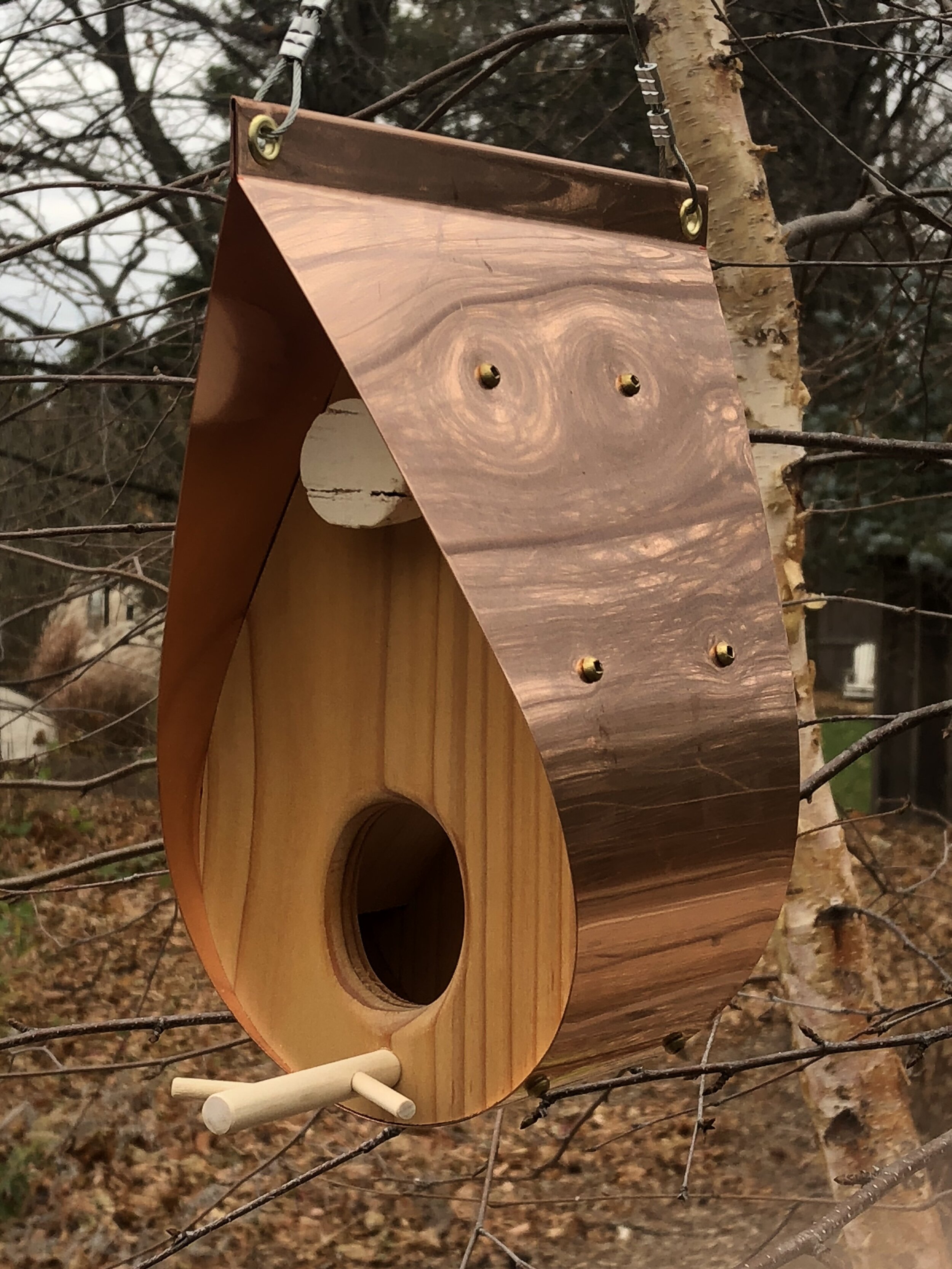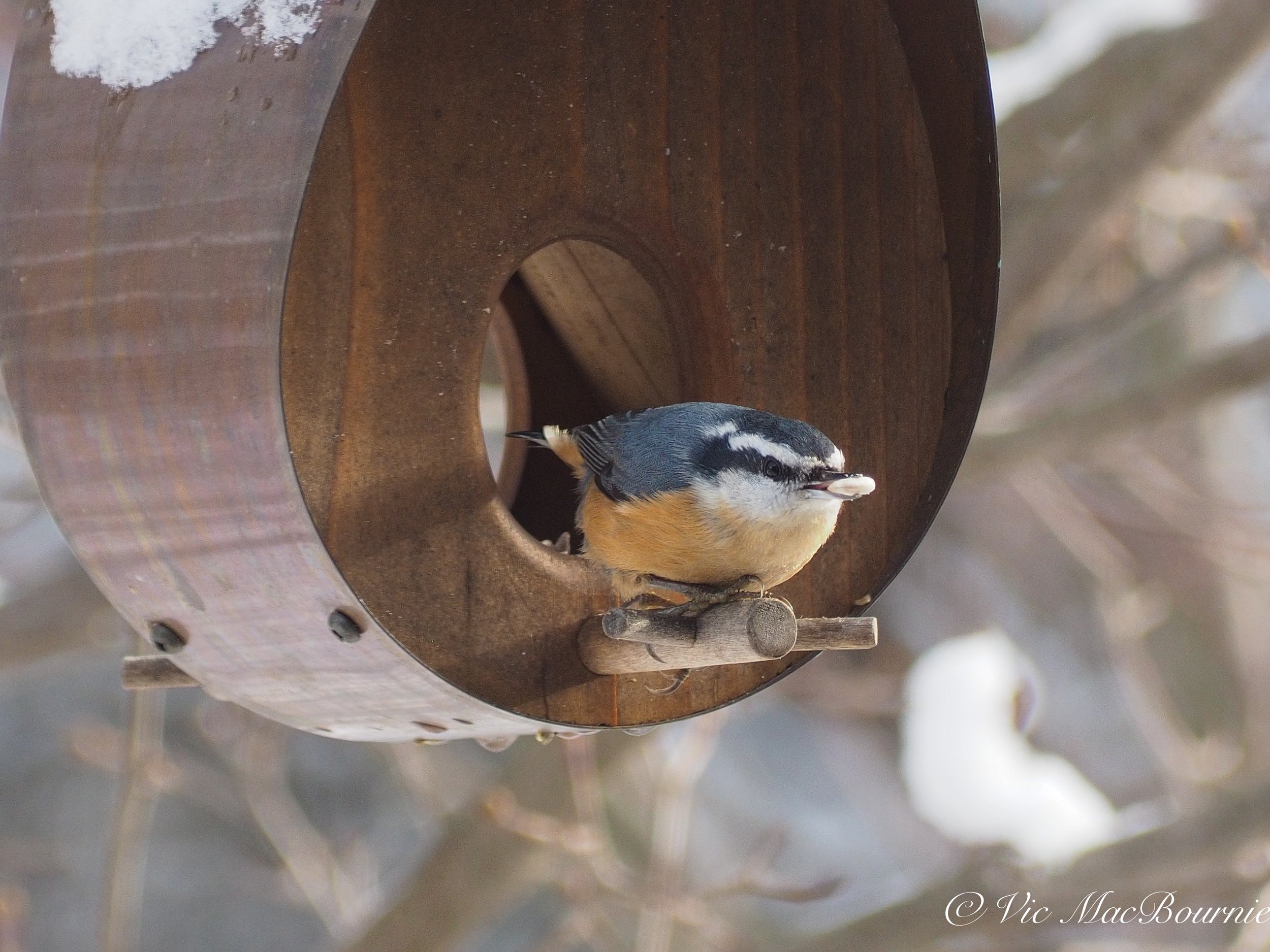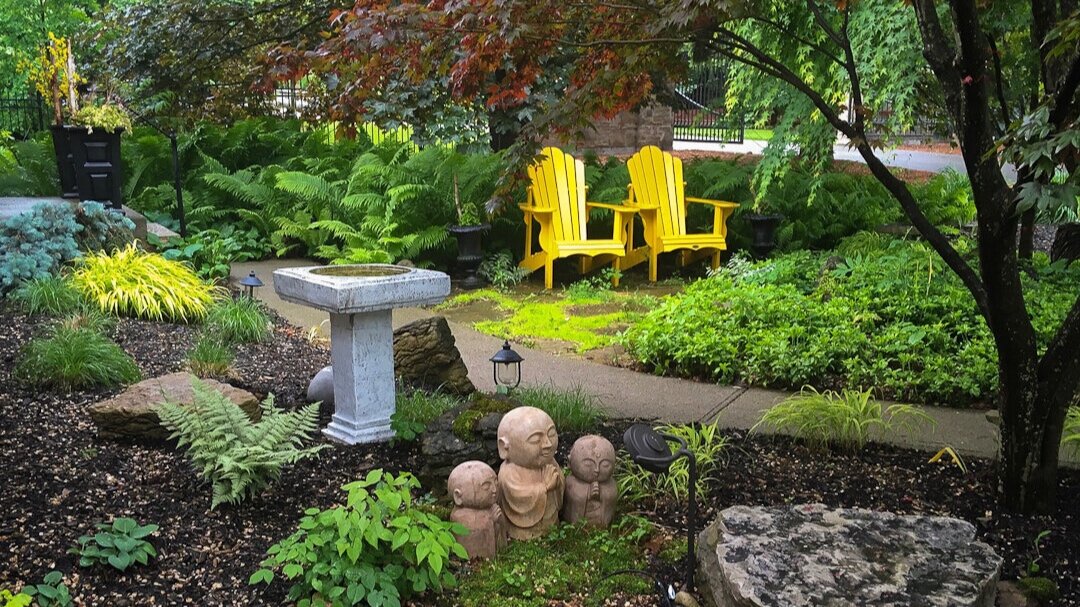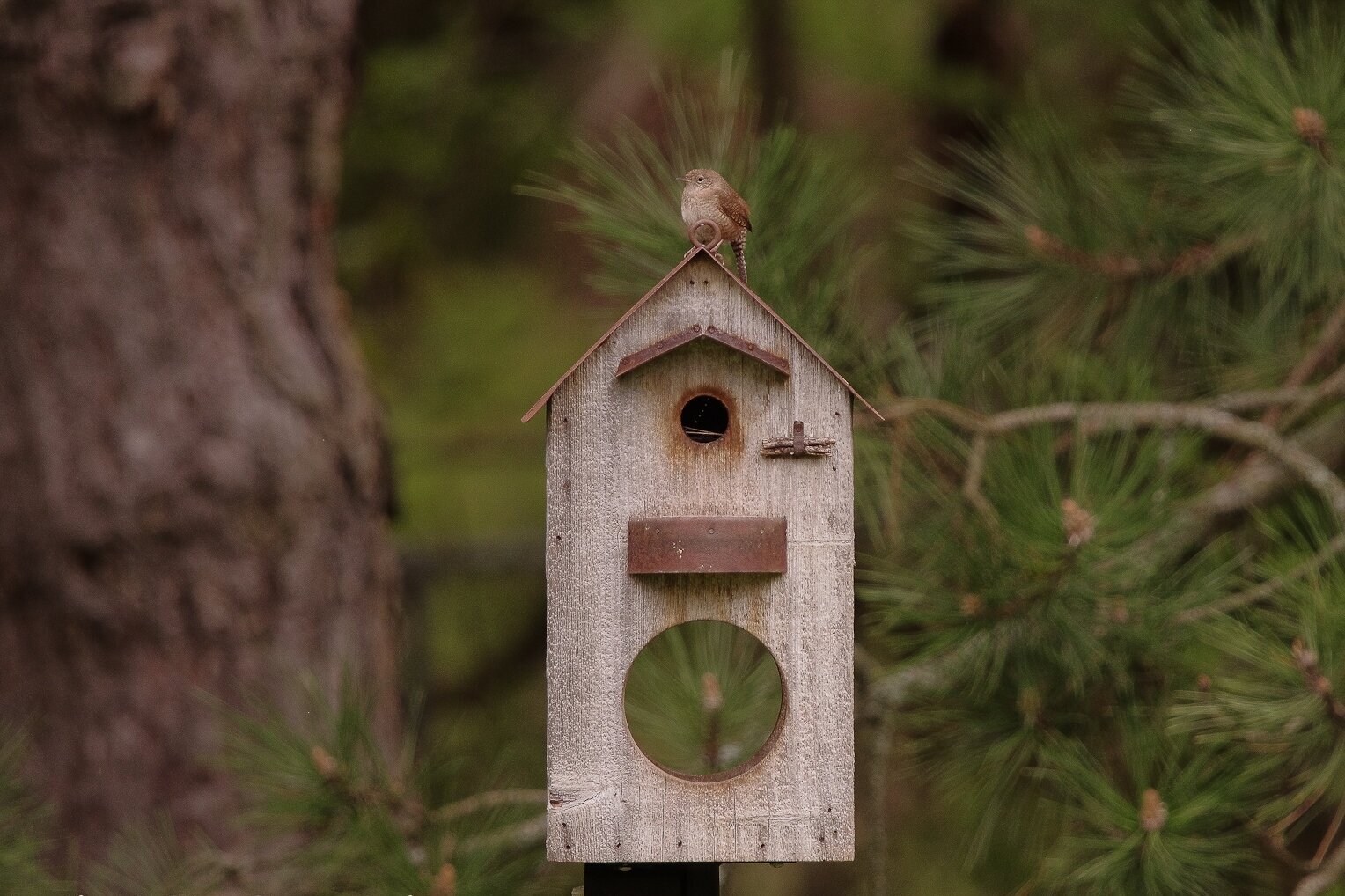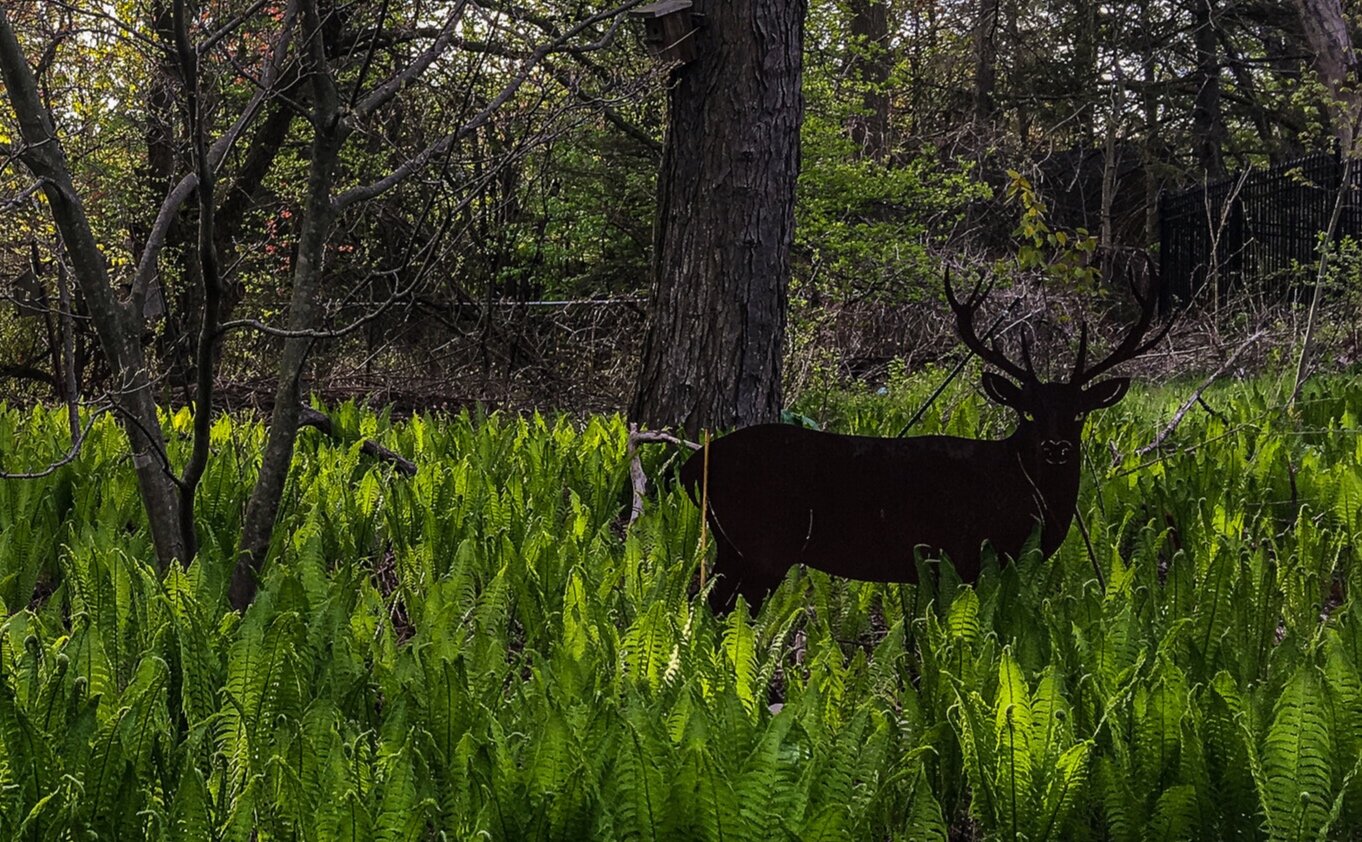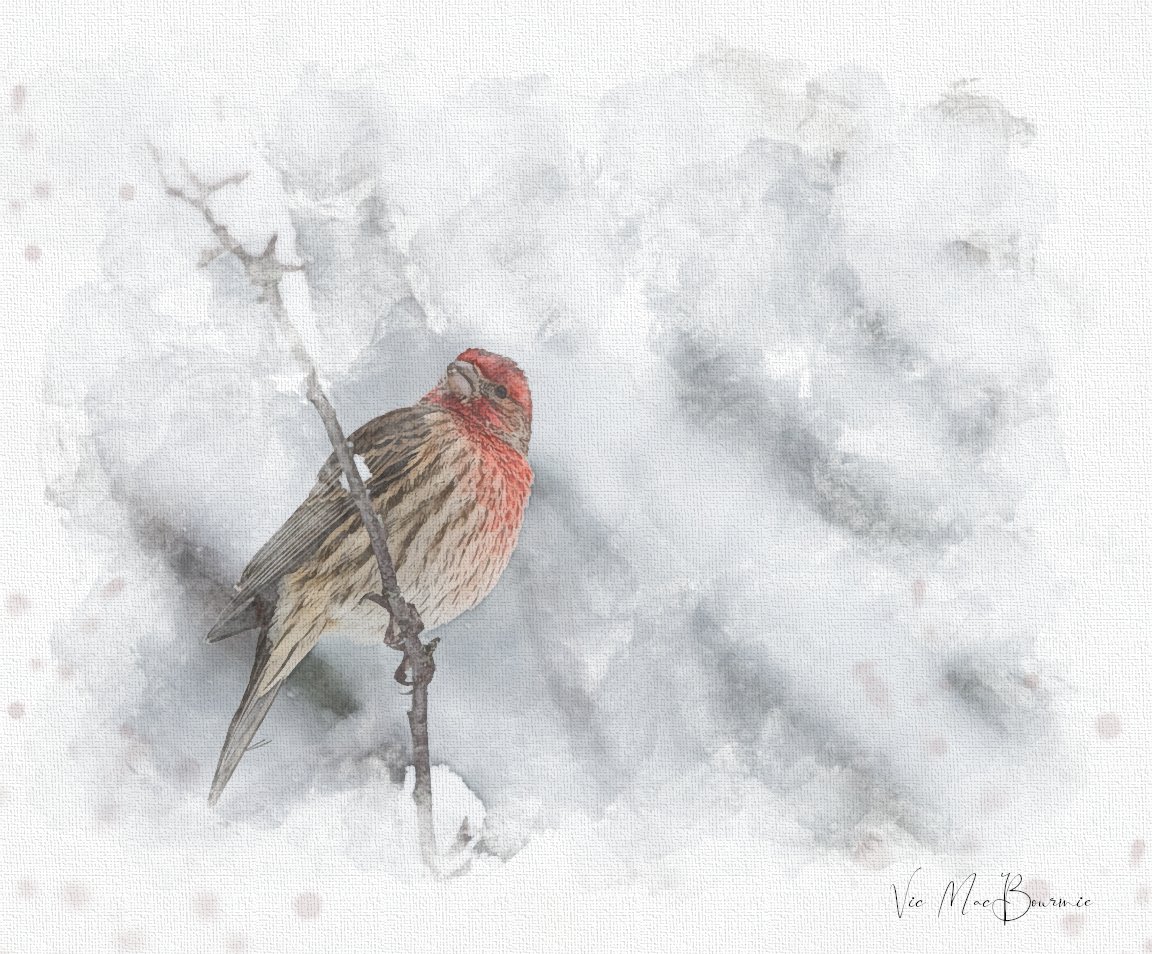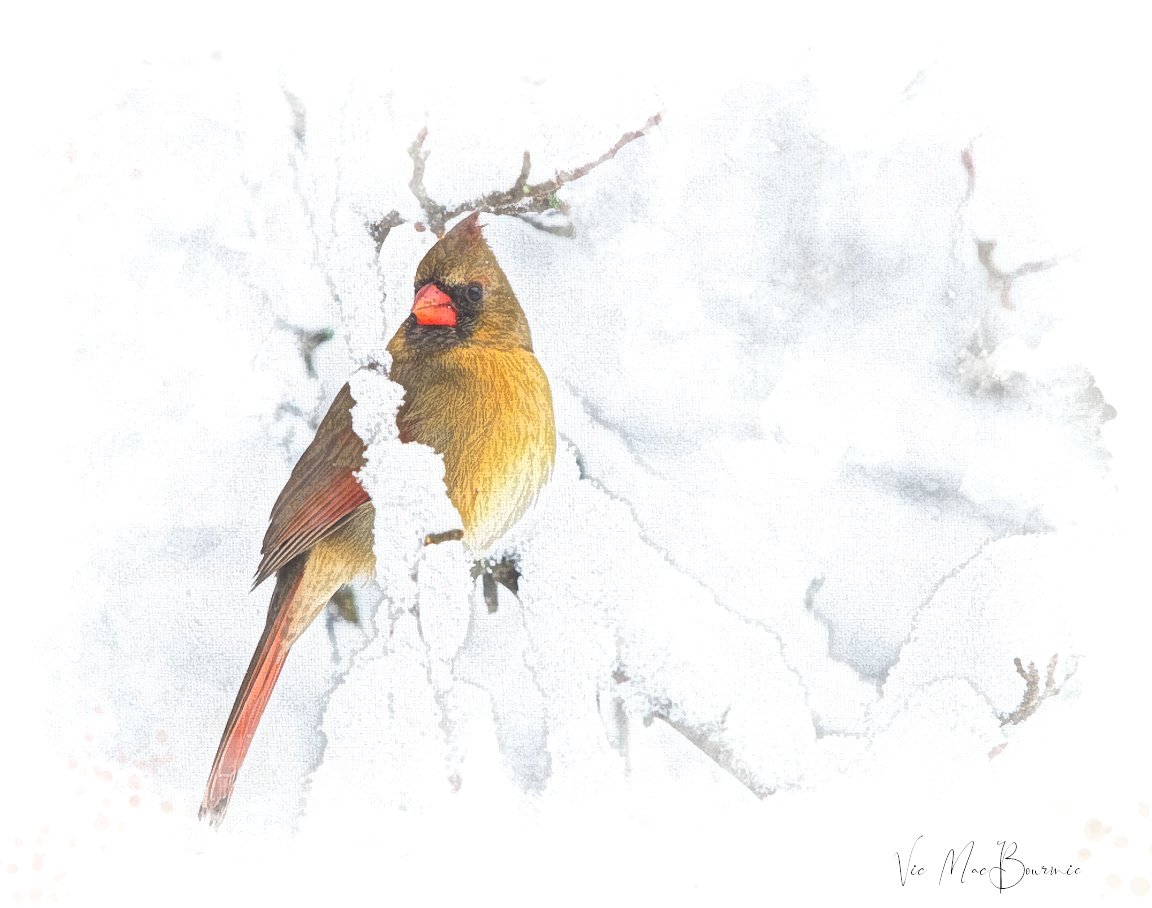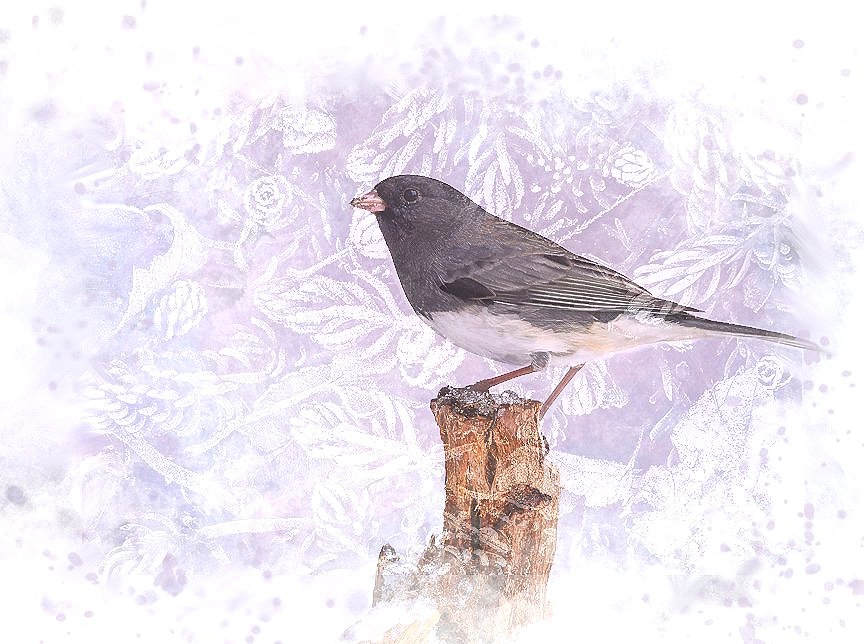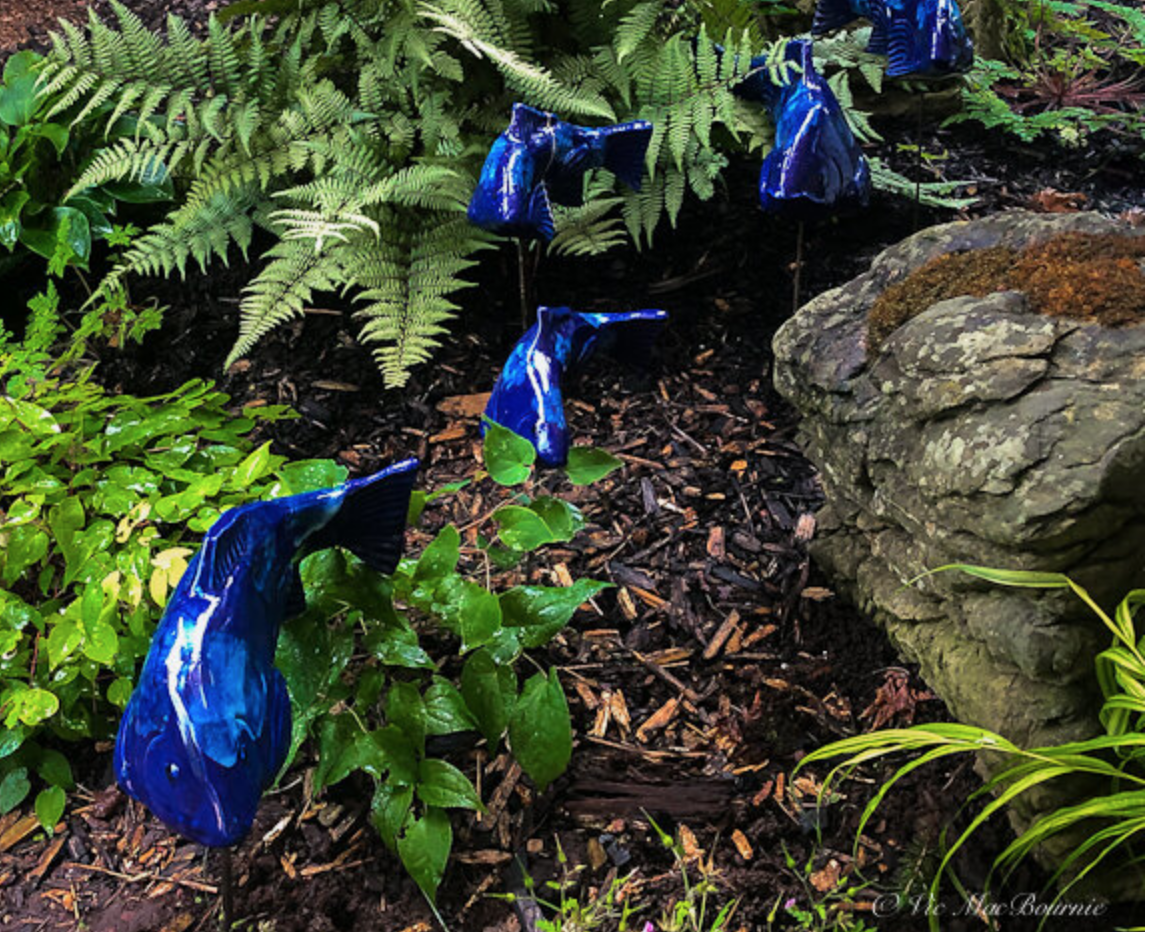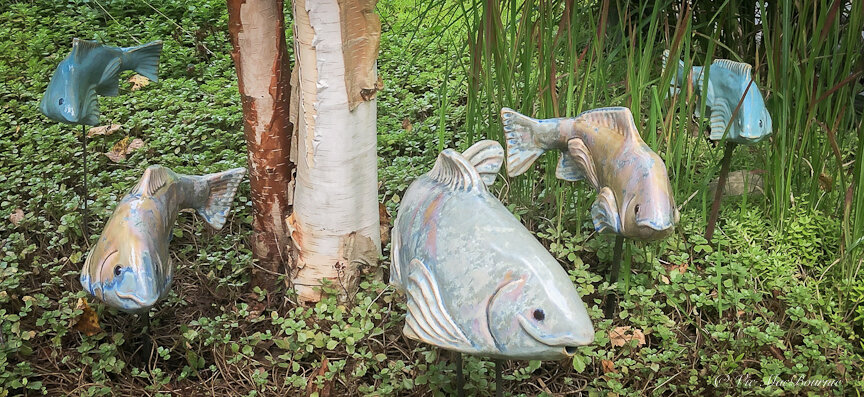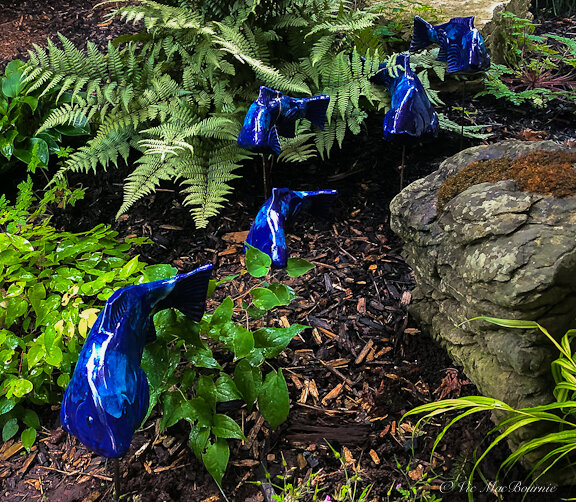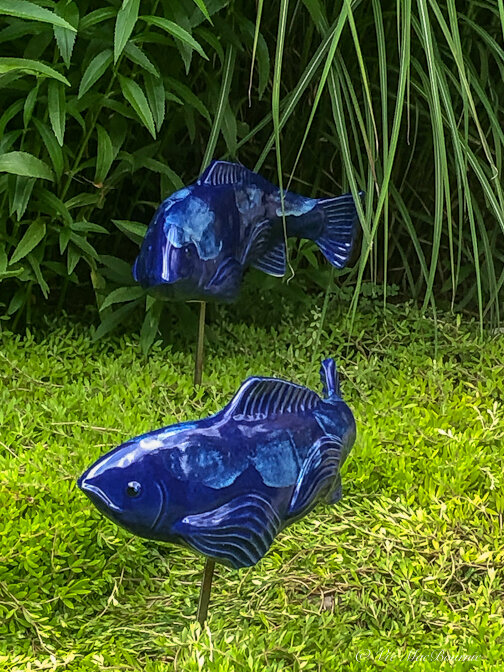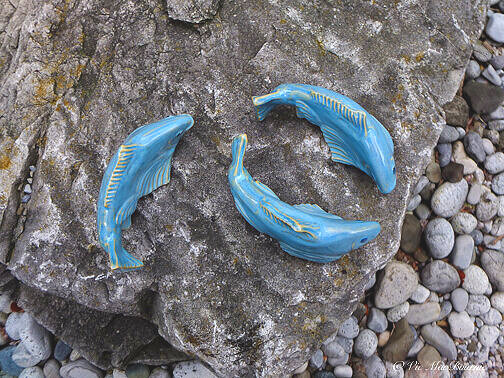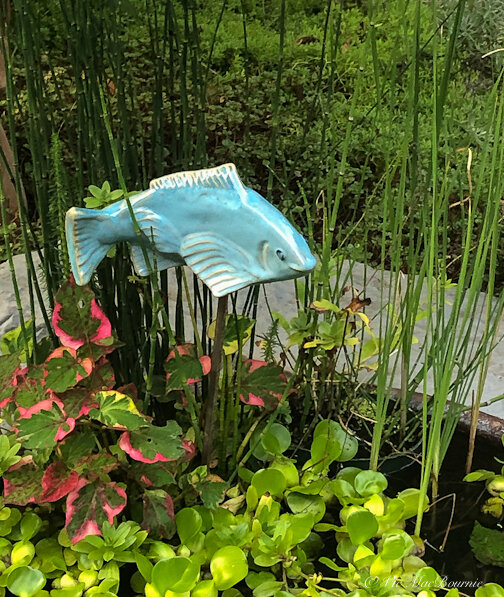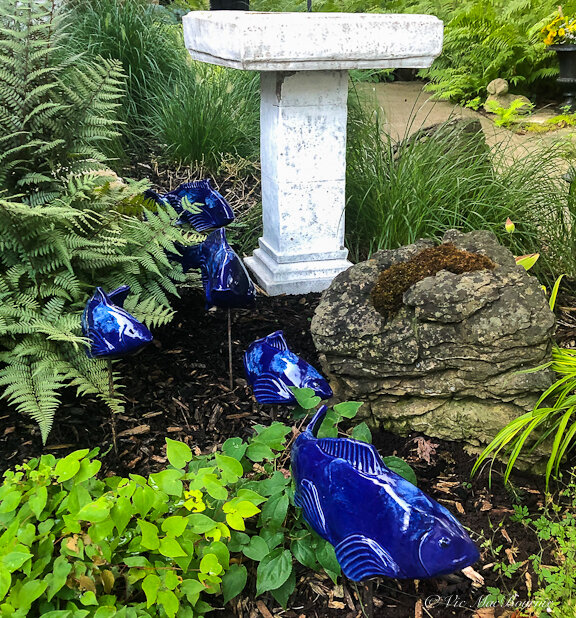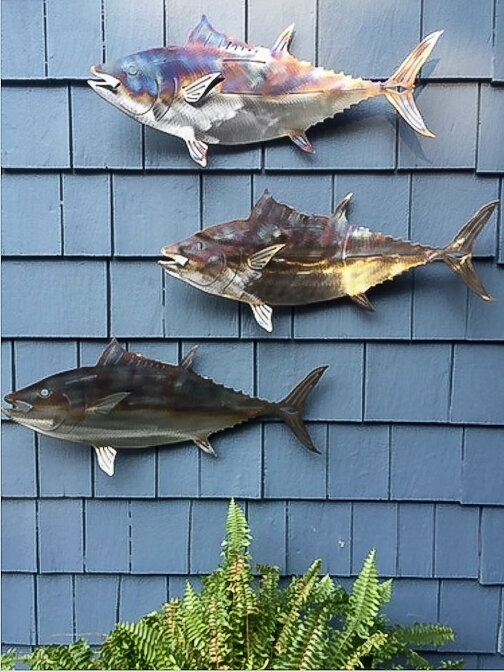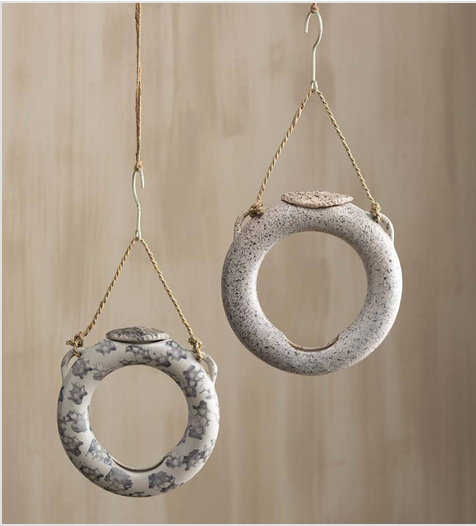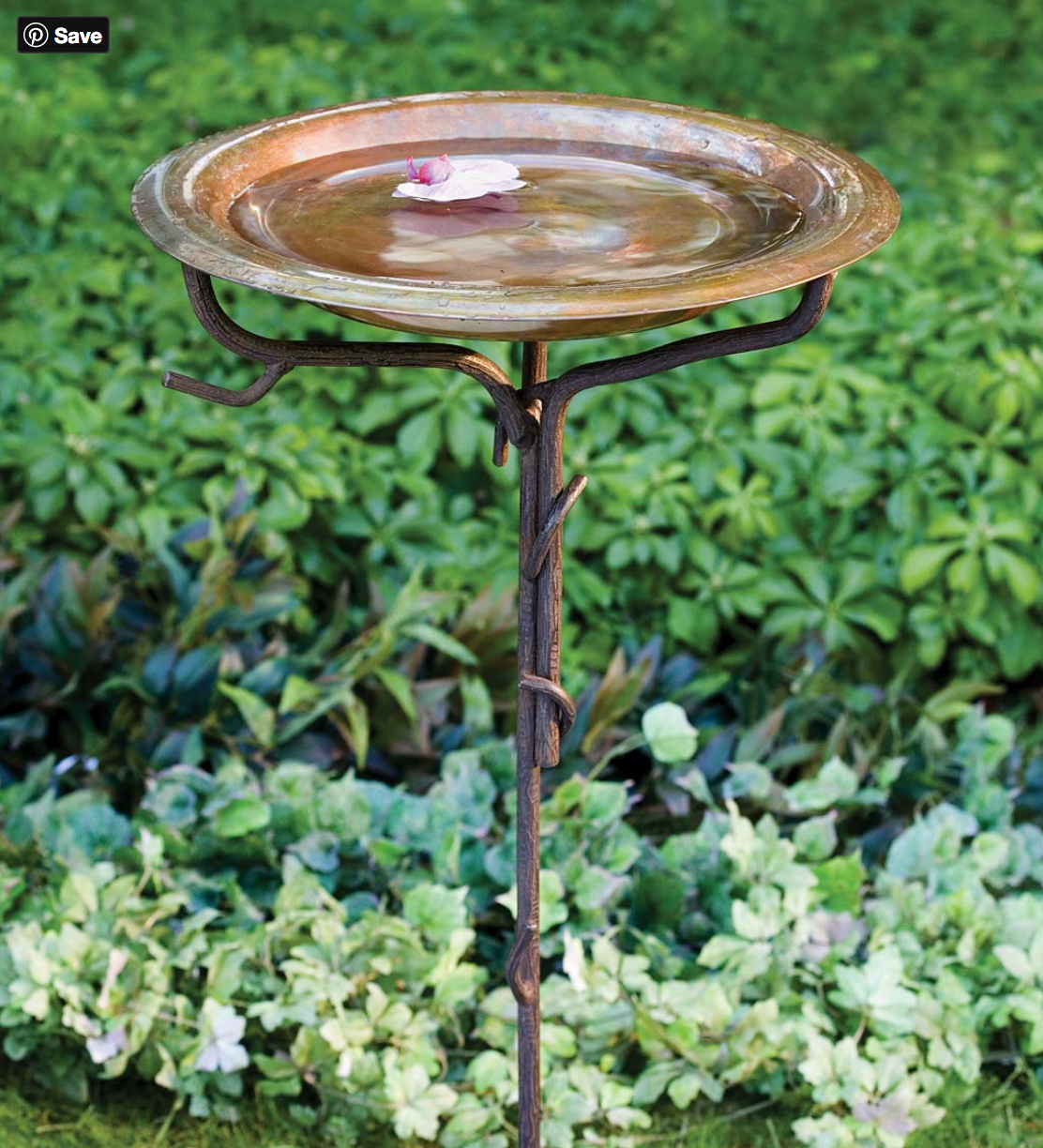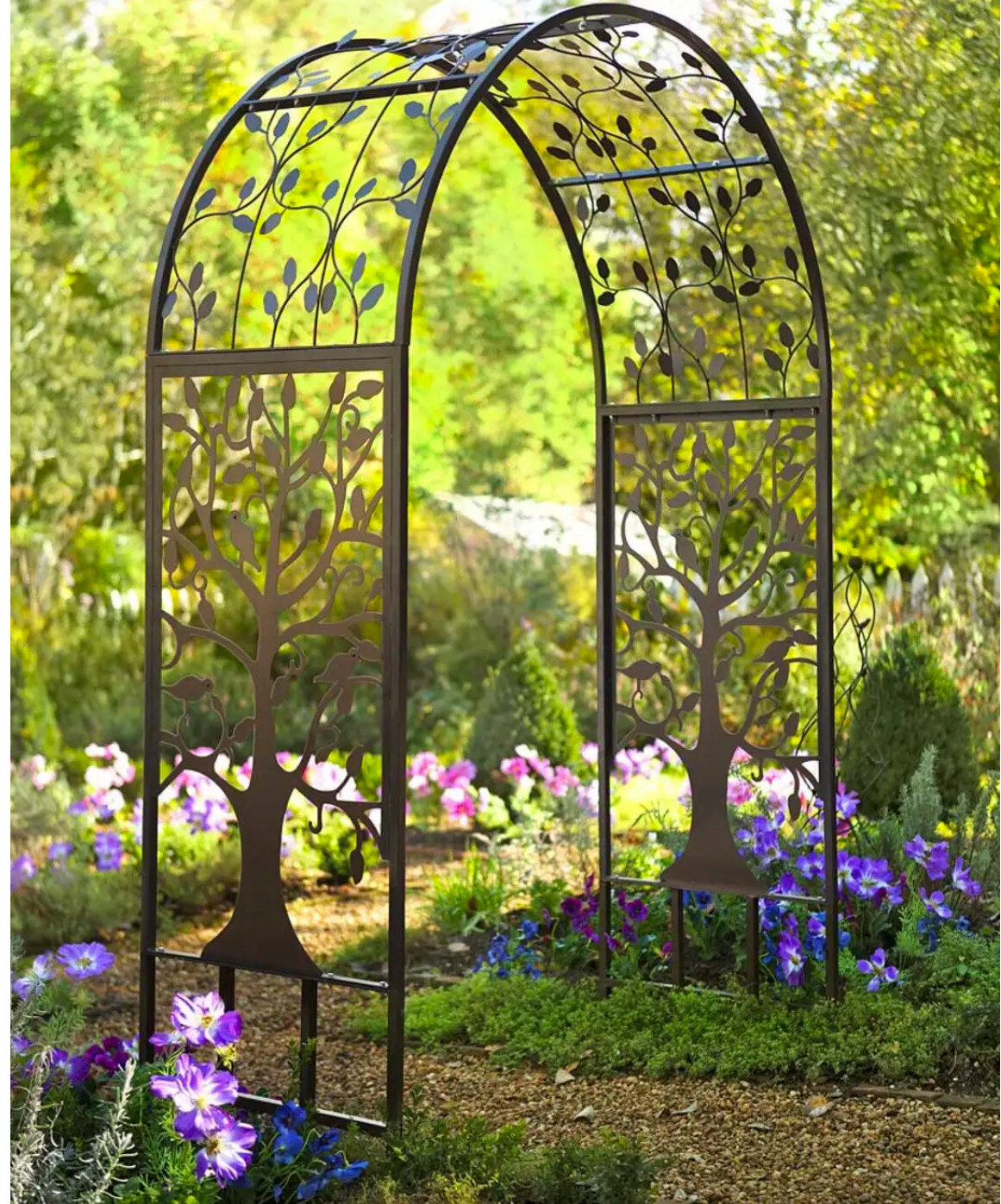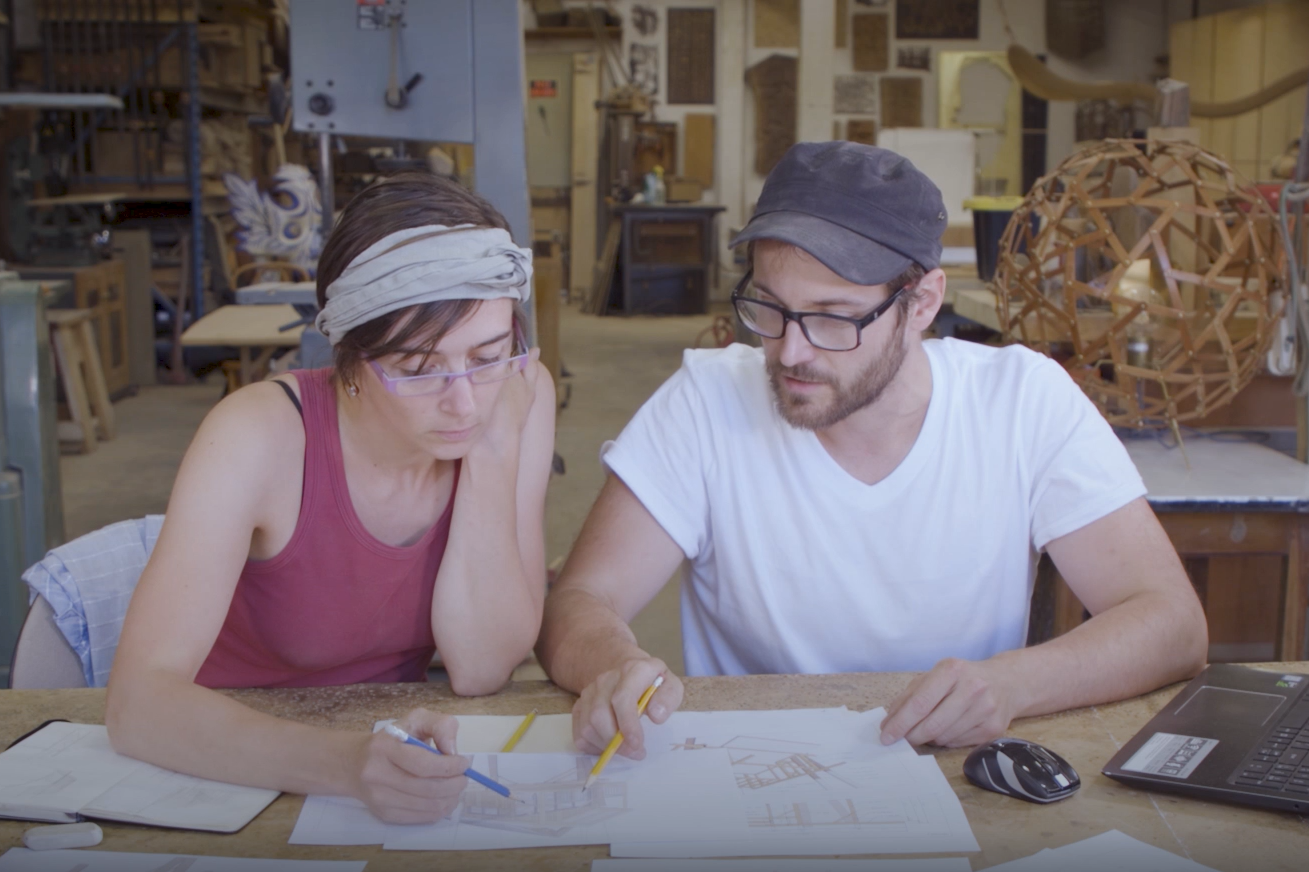Nature’s garden art (Five tips and DIY ideas)
Garden art comes in many forms in a Woodland Garden, from nature in the form of a moss-covered boulder or a fallen tree branch to a rusty buck standing watch over the garden. Garden art can be subtle or add a little whimsy to your outdoor space.
Mother nature provides its own artistic touch
If you are looking for garden art to enhance your woodland, look no further than Mother Nature – a mossy boulder, an elegant tree branch rising out from a bed of ferns. This is nature’s art at its finest.
If we take the time to really look carefully, nature often provides her art to us for free.
Fallen pine cones that “litter” the ground are works of art in themselves.
The moss-covered tree trunk works perfectly placed along the woodland pathway.
These are the gifts nature gives us if we look for them.
Look for natural materials that get better with age
But relying entirely on natural elements as art may not be enough to satisfy every gardener’s desire to inject a little sophistication and a touch of elegance into their woodland.
If you are looking to purchase artistic elements for your garden, consider investing in natural materials that age gracefully. Almost anything made with copper will improve with age.
That patina copper takes on with age is just too beautiful not to invest in if given the chance.
I think garden art works best when it is not only elegant and sophisticated, but serves a useful purpose.
An elegant birdbath is itself a piece of garden art. But, when a cardinal is added to the scene, nature’s art truly shines.
Copper birdhouses and birdbaths ideal for the woodland
Birdhouses and birdbaths are perfect examples of garden objects that, if chosen well, can not only add sophistication to a corner of the garden, but attract our feathered friends – one of nature’s finest work. How can we resist a cardinal on a birdbath or a goldfinch at a beautiful feeder?
Many of the finest bird feeders are being made by artisans and can be found on places like Etsy. The copper-enhanced Baltimore Oriole and hummingbird feeders found on Etsy are just two examples of how artisans are recognizing the value of garden art and meeting our needs for a more sophisticated approach to garden art.
The ultimate bird feeder made with copper and cedar.
There was a time not too long ago when the only garden art available amounted to plywood cutouts of an elderly husband and wife from ‘behind’ out weeding in the garden. You remember them. Everyone had a good laugh at the couple’s expense.
But those times have changed.
I wrote a post about an architect couple from France who moved to Toronto and started a business combining their architectural skills and love of natural materials to create an exquisite bird feeder made from copper and cedar. (see picture) This feeder, although expensive, will provide a lifetime of joy and can be passed on to your children. It is available in new copper (as illustrated) or copper that has already been chemically aged with a lovely verdigras patina.
There are, of course, other bird feeders that are works of art, but don’t expect to find them at your discount store.
The copper and cedar bird feeder has aged nicely and taken on a lovely patina in only a few short years. And the birds love it too.
Although a finely aged concrete bird bath has been a staple in so many gardens, copper birdbaths not only look beautiful, they have natural microbial benefits that can make them a better choice.
I wrote about an elegant copper bird bath available at a fine garden and home boutique, but similar ones are available at many bird and home stores.
For more on growing your garden on a budget, check out my in-depth article here.
Use the iconic garden bench as art
The garden bench – especially an older, moss and lichen covered bench – can be a beautiful, yet useful addition to the garden.
Many years ago – certainly more than 20 years – I was desperate to get a garden bench. We lived in a typical subdivision and I was working diligently to create a mini woodland garden in the yard. The bench represented a destination along a simple path in this tiny garden. I wrote an earlier post on designing a woodland garden in a small yard and focused on the importance of a pathway in a small garden to help the viewer experience the garden as they walked through it.
Not only did our traditional garden bench provide a destination for the visitor, it offered the gardener a place to rest and enjoy the garden from a different perspective.
It’s another excellent example of how we can turn a utilitarian garden object into a wonderful piece of garden art.
Creating your own garden art is always the best approach.
Five tips and DIY ideas to add art to your backyard landscape
Look for naturally-aged garden objects such as birdbaths, birdhouses and garden benches that people are selling either at garage sales or at on-line sites such as Kijiji. I have picked up some of my favourite “art” pieces this way.
Use techniques (like the one described below) to age newer items rapidly so they better fit into your woodland setting
Most “artistic” elements are best discovered rather than presented for everyone to see. Consider using vegetation to hide your art, especially more whimsical pieces that, when unexpectedly discovered, will bring a smile to your visitor.
Purchase lasting pieces that incorporate natural materials like copper, cedar and even rusty steel that will add a rustic element to your garden.
Whenever possible, look to nature for its existing art forms. The beautifully coloured rock, an old cedar tree root, an elegant piece of driftwood. These are often found objects that add a natural element to the garden and be combined with bought items to create a lovely juxtaposition of old and new.
In those days garden art, even a nice garden bench was not easy to find. I did, however, find an inexpensive wooden bench at a discount department store and bought two. More than 20 years later they still form a focal point in our woodland garden. Never, however, do I actually sit on them. These inexpensive garden benches have taken on an incredible aged look, covered in lichen and mosses. After a spring rain, they more or less turn a soft green as the thick moss bursts to life from its more dormant state.
Our two benches now hold large black containers that are planted with colourful, hard-working annuals that create a hit of colour in the garden and draw attention to the beautiful wooden benches.
In another part of the garden, we have a small cement garden bench that is beginning its aging process. Letting it age naturally is a slow process. It might be time to help it along a little using the following method. It’s perfect for quickly aging cement containers, benches and garden statuary.
How to give concrete a mossy, aged patina
A quick search on the internet provides several alternatives to creating an aged look for new concrete. It works on statuary as well as concrete containers. Mother nature and time does most of the work naturally, but some simple steps help to hurry the effect along. What might take mother nature years to create, can be done in a few weeks or months by following these steps.
• Start by mixing a weak solution of water and black acrylic or water-based paint and apply it to the cement statuary. Let dry and apply a second or third coat. The effect is simply to give the statuary a ‘dirty’ look rather than the stark white one it often has when it is new.
• Mix yogurt or buttermilk in a bucket with equal amounts of water, compost or soil and even some manure. You can add in some crushed moss at this stage as well. The result should be a thick spreadable paste.
• Paint on the mixture to the cement statuary or container ensuring you cover all areas especially creases where moss would naturally take hold.
• Take a handful of moss and rub the surface of the concrete to spread the moss spores into the concrete.
• Finally, store the concrete statuary or container in a moist and shady spot to encourage the aging process and keep it moist for a number of weeks until you see the moss get established.
Our gardens need to be inspirational places and what better way to achieve that than to add a few pieces of garden art, whether they are nature’s art like the boulder or store-bought statuary.
Statuary is great addition for the woodland garden
Garden statuary has always been a part of the garden and works well as it ages, often taking on a mossy patina.
In my Japanese-inspired woodland garden, we have incorporated traditional Japanese statues praying together surrounded in a patch of moss. With a little encouragement, I am hoping they will take on a mossy appearance for a truly aged look.
In another area of the garden, a statue of Saint Francis, the patron saint of animals, would be a perfect addition.
We have a number of aging cement statues of small animals tucked away throughout the garden. For much of the growing season they are mostly hidden from view, tucked away in the vegetation. It would be easy to miss them on a walk through the garden.
This rustic bird house and feeder fits the woodland theme and provides the ideal home for this Carolina wren.
In most woodland gardens, however, garden art should be more subtle. Consider a trip to your local nursery or rockery in the spring and scour their new moss-covered boulders to find the one that works perfectly in your woodland setting.
In another area, a gnarly branch that fell from a tree can serve as art. Place it somewhere in the garden where it’s natural beauty can age gracefully and work its way back into the soil while it provides homes for insects, small reptiles like red-backed salamanders and toads.
The moss-covered rock or twisted branch may also form the perfect natural landing spot to catch some great photographs of birds in your garden. Encourage moss and lichens to grow in the cracks but leave enough room to tuck in a few sunflower seeds to attract the birds to the exact spot you want to photograph them.
Rusty Buck standing guard in the ferns ties in to the rustic theme of the garden art in this section of the garden.
The rusty buck as garden art
Probably our favourite piece of garden art my wife and I purchased was from a boutique garden store we noticed on a day-outing. The store was tucked away in a small Mennonite community about an hour and a half drive from our home. We both noticed it as we drove by and immediately turned around to check it out. It’s another example of a piece that gets better with age. Now every time we see our rusty buck tucked in the ferns, it brings a smile to our face. Not sure what the native male deer think when they see our rusty buck, but it’s been knocked over on the ground in the morning more than once. Could be the wind, could be a jealous buck. We may never know.
Gardening on a budget links
Ten money-saving tips for the weekend gardener
DIY Bark Butter feeder for Woodpeckers
DIY reflection pond for photography
Click & Grow is ideal for Native Plants from seed
Garden gift ideas you’ll love
Looking for gift ideas for the gardener in your life? Or, maybe it’s just time to reward yourself for all the work around the garden you have been doing. Let me help you find some unique gift ideas for your garden or a friend’s garden.
Gardening gifts For bird lovers, garden art collectors and just plain old gardeners
Gardeners ask for little more than sunshine, some warm weather and a little rain a few times a week.
That’s not to say we don’t like to receive gifts every once in a while, especially when they are garden or wildlife related.
Thankfully, there are a host of tools, trinkets and useful items most gardeners would be thrilled to receive.
Ferns & Feathers will strive to bring readers unique gift ideas from both large and small garden supply type outlets as well as home-made items from Canada, the United States, the United Kingdom and around the world.
I’ll try to update these items on a regular basis, so check back regularly for the latest items.
• Just a few items I’ve come across this month that may be of interest. This combination garden statue and bird bath would be perfect to tuck along a garden pathway or in a Japanese-style garden.
If you are looking for a little more colour in the garden, these stacking glass orbs will do the trick. Both the garden statuary bird bath and stacking orbs are from on-line home and garden retailer Vivaterra. If you have never checked out their on-line site, they offer a beautiful selection of higher-end home and garden items you will not easily find anywhere else.
• Gardening boots and shoes are a must, especially if you are in tick country. Muck Boot Company offers a huge range of gardening boots and shoes that will fit everyone’s needs. The women’s wide calf boot keeps both the dirt and ticks away, while the women’s stylish plaid boots are good for everyday use.
There are boots for kids as well as men in too many styles to mention.
Garret Wade, the fine American garden and woodworking store much like Lee Valley in Canada, offers high-end gardening tools and goodies like Grandpa’s Weeder, The ultimate green weeder that goes a long way in saving your back. It’s even currently on sale.
If you are looking for a real heavy duty bird feeder this giant 6-liter Bird Feeder from Garret Wade might be the perfect gift.
If you are like me, it’s getting harder to keep up with all the up-and-downs of gardening. This Portable Bench and Kneeler from Garret Wade can make a big difference. As described on the site: “Right-side up, it is a comfortable, extra-wide, portable seat. Flip it over, and it becomes a kneeler, particularly useful when you are doing gardening, yard work, or other jobs around the house, like painting baseboards. When used as a kneeler the handles offer support to make easy work of getting up from the ground. You can also take it along and be comfortable when watching fireworks or the kid’s soccer game. Use it as a camp stool or for tailgating.”
Could there be a more perfect gift for the woodland gardener than this Sherwood Fern Fairy Statuary with Bird Feeder. It’s time to Think Spring! at MyEvergreen on-line retailers for $165, regular $275. Evergreen is part of the Rakuten family of retailers. The beautiful bird feeder stands a full 2.5 feet tall and is made of durable, all-weather polystone to help give it a natural, carved wood look.
If you have never checked out the website Wind & Weather you owe it to yourself to wander over and take a look. They say they have a passion for the weather and it shows in many of the high-end weather instruments that are available at the California-based store. They also offer distinctive garden decor and artistic objects for the home. They are proud to say they “shop the globe” to provide customers with unique items.
• Still on the bird theme, another elegant addition to the garden is this polished Copper Hanging Birdbath measuring just over 12 inches in diameter. It can be purchased with a holder and chain that is made of black wrought iron. The whole thing is sure to age nicely in the garden. Although anything copper is obviously an expensive purchase, the inherent beauty of the metal and the fact it ages gracefully with the garden means it’s always a great investment. The wrought iron holder will rust and age the way wrought iron tends to do, so if this is not your style you may want to look at something different. Or, just purchase a copper bowl and use it as an on-ground water resource.
This on-ground bird bath is ideal for not only birds but other backyard critters that can’t jump or climb into a regular bird bath. A couple of these spread throughout the garden will give a hand to many wildlife species from toads, chipmunks, snakes and, of course, birds.
My post, Bringing water into the garden points out how important it is to have an on-ground water source in your garden for small mammals and reptiles as well as birds. This is an opportunity to add an on-ground feature that would make an elegant addition to any garden tucked into a low-growing ground cover, maybe thyme, moss or stone crop. We have our two on-ground water features tucked among the stone crop sedum that has grown around the water features and make them look like they have always been there.
Both bird baths are available through Amazon. A search on the Amazon site shows many hanging bird baths, some brightly coloured and at various price categories. Giving a bird lover or garden enthusiast a bird bath rather than a feeder requires them to do nothing but hang it up and add a little water every day or two.
This page contains affiliate links. If you purchase a product through one of them, I will receive a commission (at no additional cost to you) I try to only endorse products I have either used, have complete confidence in, or have experience with the manufacturer. Thank you for your support. This blog would not be possible without your continued support.
How to create bird artwork from digital watercolour paintings
Creating artistic interpretations from photographic images can be an extremely rewarding endeavour that is not only a way to get your creative juices going during the cold days of winter, but an excellent way to see your photographs in a different light.
Turn backyard birds and garden photos into works of art
Since digital images became mainstream in the world of photography, learning to manipulate pixels has become increasingly important for serious photographers.
For garden photographers, artistic interpretations can turn your favourite flower and bird images into beautiful works of art. And who doesn’t appreciate artwork of birds.
There was a time photographers really didn’t need to know about software programs. Jpegs, tiffs and RAW images had not been born and perfect exposure was crucial to keeping an image or throwing it in the wastebasket.
Go here for more Hummingbird images including digital art.
Much of their “artistic creations” centered around in-camera techniques such as selective focus as shown by the colourful tulips (above).
For more on selective focus in garden photography check out my article on photographing snow in summer.
(If you are interested in exploring garden photography at a higher level, be sure to check out my comprehensive post on the Best camera and lens for Garden Photography.)
Today, if you take photography at all serious, you not only need to know the basics of photo manipulation, you almost need to be an expert in some way.
These days my main photo data base and manipulation program is without a doubt Lightroom Classic, but it’s not the program I use to transform my photographic images into watercolour paintings.
While most photographers focused on improving their images, I have always been interested in transforming my images into a more artistic interpretation of that same photograph. Over the years, I’ve spent a lot of time playing with the likes of the many variations of Photoshop before discovering Painter (Mac Link) (Windows Painter link) – a program that can best be described as a fine artists’ version of Photoshop. In other words Painter is to artists, what Photoshop is to photographers.
This seemed a perfect marriage to achieve my goals of turning photographic images into works of art, accept without any formal training in fine art, and facing more tools, paintbrushes and artistic choices than I could imagine, to say I was a little overwhelmed was an understatement.
After “a lot” of computer time trying to understand the intricacies of Painter, I eventually taught myself the basics and proceded to work on animal portraits for hours and sometimes days to get them where I wanted.
For my animal portraits, I used a process that involved meticulously going into the original photograph and softly smudging tiny areas of the image to create a sort of painterly effect. For the most part, all this tedious work went unnoticed in the final versions, but it all served as a learning process and, to this day, I still like the results.
Since the animal portraits, I have continued experimenting with painterly images.
Fast forward to today. I no longer use Painter for my artistic endeavours and still can honestly say that I have no clue what I’m doing, but I am getting happier with some of the results.
And, there is no better way to pass time in the cold winter months than taking an afternoon going over some of your favourite images, isolating ones that you think might make nice watercolour images, and experimenting with one of the many programs you may already have to create your own works of art.
Right now I’m using a free program that you download from the web called GIMP, which is an excellent substitute for Photoshop.
The equivalent “free” program for Painter fans is Krita, another excellent program that has endless possibilities for artists looking to experiment in the digital world.
The GIMP community – particularly the available YouTube videos – make learning the program relatively easy and extremely enjoyable. Following the step-by-step procedures on the various YouTube channels will have even the most inexperienced user creating nice images in a relatively short time.
Try searching “Turning photos into art” and you will be rewarded with a host of videos that will start you down the path to your particular artistic vision. Not all the videos focus on turning your images into watercolour images. Many focus on pencil drawings (which I have also experimented with), digital drawings, pastels…
After learning the basics from YouTube, I proceeded to develop my own method of creating the watercolour images from my photographs. Although the procedure for each image is similar, I like to let the original image dictate the various steps needed to attain the finished result.
It’s difficult to give you a step-by-step guide on how to create these images because I like to think each image is it’s own work of art and I rarely approach each image in the same manner.
I will, however, provide some guidelines that will help you get started as well as a general guideline of the steps I take in creating an image.
This image combines a Junco and a background of a frost-covered forest floor for an interesting example of using photography to create bird artwork.
Five tips to turn your photographs into artistic interpretations
1) Start with a slightly overexposed image to provide the basic structure of a delicate watercolour image.
2) Recognize that the subject does not have to be tack sharp for an effective image. The process of transforming the image into a digital painting does not call for tack-sharp images.
3) Always use layers (photoshop, Painter, GIMP and KRITA and most photo manipulation programs offer them) so that each manipulation can be done separately and the layer can be discarded and redone if you have problems.
4) Consider purchasing a Wacom drawing tablet or adding a pen to your existing ipad if it is compatible that allows you to paint directly on the screen.
5) Your finished result looks its best if the main image has a gradual softening leading to the edge of the image and includes a white border surrounding the edge of the painting.
6) When you are satisfied with the image, you must flatten the layers into a single image to save it as a jpeg. Be sure to first save it with all the layers first, so that you can go back to it and make changes.
Creating the image in GIMP: A step-by-step guide
To put it mildly, the process can be complicated.
Without getting too specific, let’s just say the process starts by creating 6 or 7 layers of the original image.
Each layer is given an appropriate name to help identify it while you are working.
The first layer I create is a rough watercolour layer using the filter “waterpixels.” I follow that layer up with another “waterpixel” layer that has finer details.
The next layer is created using the cartoon filter and manipulated in such a way as to obtain what you think is just the right amount of underlying black lines in the image. This helps to create the illusion that the image was first sketched out with a light pencil
The next layer is usually created with a white tracing paper over it. By reducing the opacity slightly, the image faintly emerges through the tracing paper.
Now take the erasure, pick one of the texture brushes from the assortment of brushes or you can create your own. Set the opacity to somewhere between 60-80 per cent. Begin dabbing the image, starting in the centre or on the main subject. Continue dabbing it (removing the tracing paper) but leaving the edges white.
At this stage you can turn the opacity on this layer to its maximum to see how the image is developing.
Next, continue erasing the white tracing paper until the image emerges the way you like it.
It’s a good idea to change brushes and opacity as you are working the image with the erasure tool.
Once you get it looking the way you want, it is time to add some paint splatters. This time choose the paint brush rather than the erasure and pick one of the splatter brushes.
Use the eyedropper to obtain a colour you think will work well as paint splotches. I usually try to keep the splotches very subtle.
Splatter the corners of the image but keep it subtle by leaving the opacity of the spatters very low.
Finally, add another layer with a white background and pick the filter “canvas” or “clothify” or, if you have them, various art papers. This one will need major adjustment to get it to blend in with the image without obstructing the visual presence. I find using the “multiply” mode can work well.
At this point you have the basic elements of the painting, but you now have to go into each layer, find the best opacity for your particular image and the best blend mode. That can take a lot of time and experimentation to get it looking the way you want.
Obviously, this process is not created with a one-click “painterly image filter” in photoshop.
There are programs and apps that will allow you to turn an image into a photograph, but the results vary too much to depend on them to create the image you desire.
Besides, it takes all the creative inspiration out of the finished result.
This process is not meant to provide immediate satisfaction for the artist. Each image needs its own approach, but once you have mastered the process, recognizing the necessary steps given a particular type of image, becomes a simpler process.
The amount of time it takes to create an image might come down to an hour or two rather than an entire afternoon. And, if you save it properly, you can go back later and continue to work with it.
Who knows, maybe if you like the results you’ll be inspired to turn your works of art into a lovely book or your garden art. This year I created my first Garden Photographic Book, maybe next year it’ll be a book of Garden Watercolour images.
In conclusion
There are days, especially in the cold of winter, that I barely come out of my office because I am too wrapped up in working on digital images of some of my favourite garden images. Some are a complete failure and I am still trying to figure out which images work best. I think, snow images work well simply because of the already delicate feel to the them.
No matter, there is no better way to pass the time than to sit down at your computer, push some pixels around and work some artistic magic with a fine cup of coffee (or wine) and your favourite music playing.
It doesn’t matter if you are the only one who feels the magic.
Fish In The Garden: Style, movement and a touch of whimsy
Tyson Weiss's exquisite artistic ceramic Fish In The Garden add a sense of movement and life to any garden. The cobalt and orange koi add a splash of color to your garden, while the trout can be used to add a subtle, artistic and more natural touch to your woodland garden. The fish make the perfect gift and provide gardeners with an opportunity to experiment with placing them around the garden.
Unique garden gifts: Ceramic Fish add artistic touch to any space
There’s no reason not to have Fish In The Garden, thanks to ceramic artist extraordinaire Tyson M. Weiss.
Whether you have a pond stocked with koi or not, there’s always room for these impressive, artistic fish in a multitude of colours. I’ve admired this unique form of garden art since the first time I saw a picture of them and always wondered where they would look best in my garden.
The simple answer: Almost anywhere and everywhere.
These exquisite ceramic fish, in a multitude of colours and sizes, bring your garden to life as schools roam through ornamental grasses, ferns, mosses and flowers bringing a sense of movement to the garden. Groupings of three, five, nine … weave between moss-covered rocks in the Japanese-inspired garden and can remain there throughout the winter months bringing colour and style year round. They are at home in any garden – running up a dry river bed, rising just above a pond or even submerged to create the illusion of real Koi in a pond devoid of fish.
A school of fish wander through the garden over sedum around a birch clump and through the ornamental Japanese blood grasses creating movement and a sense of style in the garden.
This school of cobalt-coloured fish swim through the ferns and grasses of our Japanese-inspired garden creating a flow down a small hill and around a moss-covered boulder.
Tyson refers to the “flow” created by the schools of fish as a “fluid aesthetic” created by the curves of the swimming fish as they “move” as one through a garden.
“With the multiples, we can create these curves, and with those curves, (the fish) can curve in response to an element of the landscape,” he explained in a 2012 article in the Portland Press Herald. “Around a rock, and then curve back this way around a tree, so it fits. No garden gnome or concrete bunny rabbit will ever have context like that.”
In fact, by creating schools of fish, he explains in the article, it’s possible to “perfectly match the shapes of diverse landscapes and architectural elements. Channel the fish around a rock, through plantings and back out again. Our sculptures — brushes, if you will — bring out the artist in every gardener.”
“If that means making a bazillion fish to get it right, that’s what you have to do.”
Sharing this creative process with gardeners is, without a doubt, one of the greatest benefits of his inspirational garden art.
“Our sculptures are exquisitely crafted of a variety of high‐quality materials. They are moderately priced, somewhat above low‐end polymers and plasters, and well below expensive garden sculptures of stone and metals,” Tyson explains. “They’re even more affordable than some small shrubs and trees.”
Tyson explains that every component in the “school” reflects the hand of the artist.
“The sculptures are hand‐sculpted detail and hand‐painted. No two are exactly alike. Ten years of experience has evolved a proprietary process to meet high demand and yet preserve our founding vision. There is no mass production.”
How to place the Fish In The Garden
Unlike most garden art, where homeowners are left with only the decision of where best to place it, Tyson’s ceramic fish provide gardeners with a multitude of artistic decisions ranging from where to place the school, how many fish should be included and how to organize them for best aesthetic value. This process is, in itself, both artistic and immensely satisfying when done well.
But even when it doesn’t work as well as you hoped, it’s easily changed.
Did I say the entire experience is more fun and certainly easier than planting a new garden bed or large container. Take my word for it, whether you consider yourself creative or not, experimenting with these schools of fish might be the most fun you’ve had in the garden in years.
If you are unsure about how to place the fish in your garden creatively, Tyson’s informative website at Fish In The Garden includes several videos providing examples on how to best creatively place the fish in your garden.
The impressive site provides complete details on what styles of fish are available, how to order them, prices and other details about his artistic ceramic fish. (For details on his colourful Koi ceramic fish go here.)
The smaller ceramic fish are perfect for container plantings. Here, three work their way around Northern Sea Grass and petunias in one of our window boxes.
Can I give Fish In The Garden as a gift?
For those who might want to give the fish as unique gifts to gardening friends and family, there are even gift cards available to purchase on the site that can be sent directly to the recipient. (Information on the gift cards is available here on his website.)
The fish are the perfect gift for homeowners, especially those who appreciate the artistic whimsy that the fish can provide. These schools of art look just as much at home in a woodland garden as they would in a small, contemporary urban garden. In fact, the splash of colour that the more colourful koi provide, might just be the punch of colour to take the small urban garden to new heights.
And, by ordering the gifts from Tyson’s website, the fish can be delivered directly to you or the recipient of the gift wherever they choose to garden. The perfect gift for a friend or family member who lives in a different country, state/province or far off city.
Fish In The Garden can be shipped worldwide
Tyson is quick to point out that they can ship to virtually any address in the world, adding that that there are restrictions on some products, and some products cannot be shipped to international destinations.
The enjoyment homeowners get from having the fish in the garden, however, does not compare with the enjoyment Tyson gets from knowing his artwork is gracing gardens in his hometown of Falmouth, Maine and in gardens around the world.
“I love it. I invented something that makes people really happy that could last indefinitely,” he says. “If you read the reviews online there are SO many stories of people meeting their neighbors and making new friends over passersby seeing these fish and asking about them.” he explains in an email to Ferns & Feathers.
“There was a long stretch where most people didn’t get it at all because there was nothing like it out there,” Tyson explains.
“The early adopters were the landscape architects, interior designers, art gallery owners: People who were both intelligent and creative that had an eye for something new. Now that people have seen them in so many shops, botanical gardens, private homes, magazine articles, social media awareness of this new idea is spreading a lot faster.”
To say his fish have made an impact worldwide is an understatement.
“Last week we shipped four orders to Australia. I've shipped to Ireland, England, Germany, Switzerland… Singapore…. Lots of people from abroad have bought them in gift shops and carried or shipped them home,” Tyson explains.
And if that is not enough, his fish are even likely gracing the home of a former American president.
“Last year a gift shop owner in Florida told me (former president) George Bush Jr. and his wife, Laura, came in and bought a bunch of fish,” Tyson writes.
Now that’s something to get excited about.
To say his clients are impressed with his work, is an understatement.
He recalls one woman who purchased 90 of his fish to give as gifts to her family.
His website is full of clients proclaiming their love for the garden art and the joy the fish have brought to them. One of his clients writes about their experience on his website:
“I had recently expanded a patch of ornamental garden this year with a Japanese theme, using traditional plants, and was searching for the most perfect and unique ornaments to add other than the typical “Buddahs” and “pagodas,” water basins and fountains that you can find anywhere,” writes one gardener.
“These fish are perfect! It looks so magical to see my koi “swimming” through my garden and have gotten many compliments on how unique and “clever” they are. If you want that little “extra” that sets your landscaping apart from your neighbors and friends... you need these fish! I am completely happy when I see them and I will most definitely be purchasing more to increase my “school.”
A grouping of fish look as good on boulders as they do in garden greenery.
Fish placement in our garden
In my garden, different schools of fish move from the front to the back gardens depending on my mood.
In the Japanese-inspired garden, a school of fish swim around our elegant ghost fern, down a small hill heading for a moss-covered rock. By adding a few more fish, the school travels past the rock over the mossy ground creating a natural curve as they head for the safety of a massive boulder.
A few small changes and the school is off in a completely different direction.
Changing the design involves nothing more than pushing a metal stake (provided with each order) into the ground.
Not far from the Japanese garden, a school of three small fish swim through the colourful and lush planting of our window box providing a little whimsy for garden visitors and one that can be seen from both outside and inside our home.
Even a single fish in the widow box or in a small container works well to add a touch of colour. They would look as good in a container on a garden patio as they would on a balcony overlooking a skyline 20-storeys high.
In the backyard, a larger school of fish work their way up past the dry river bed, over the sedum, through the blood grass and around one of our birch tree clumps. Their presence contributes to the feeling of movement in the garden. Just down along the river’s bank, a small group of fish peek out from the tall stems of native obedient plant looking to join the larger school.
In another area, I move a group of three fish to see how they look hiding in the fountain grass and provide visitors with an unexpected surprise as they walk out into the woodland garden.
As the seasons change, so too do my artistic opportunities to move the schools of fish throughout the garden.
So much fun.
No amount of traditional garden art will provide so many creative possibilities and opportunities to play with natural design in our gardens.
Certainly none will provide the same natural movement that Tyson’s fish create. Nor will they work so seamlessly into the natural landscape quite the way the fish organically fit naturally in the garden.
A single fish adds a splash of colour as it swims above the plants in the patio container water garden. It would look just as good in a window box 20-storeys up overlooking a city skyline.
What makes this garden art so special?
• The fish can stay outdoors in any climate, including freezing Maine or Canadian winters.
• The fish are in gardens from Alaska to Arizona
• They will not break in the cold or fade in the sunlight
• All fish come complete with a rod for placing them at the proper height in the garden
• They come in a tail left and tail right design. Schools of the fish look best (natural) with both tail directions being used to create flow
• The fish can be submerged in water for stunningly realistic results or simply to add to an existing stock of real pond fish.
Fish bring Woodland garden to life
For woodland gardeners, the schools of fish provide a multitude of opportunities to not only add a natural artistic element to our gardens, they are so easy to move around the gardens that they create changing possibilities throughout the seasons
These fish form the perfect garden art that so many of us have been searching for to bring our gardens to life in a stylish, yet subtle and convincing natural way.
Display ideas for Fish In The Garden in your Home and Garden
In the Garden:
Use schools of fish swimming among ornamental grasses and allow the grasses to hide parts of the fish for a truly natural look. Let your visitors discover them as they stroll through and around your garden.
• Place the fish among your ground covers to add interest and create the illusion that the ground cover is the sea floor and the fish are floating just above it.
• Place the smaller fish in window boxes and patio planters for year-round interest
• Bring your dry river beds to life with a school of large trout or koi running up through it around driftwood and boulders.
• Use the fish on a stone wall, large boulders or fountains and even in bird baths and on patio tables
• Incorporate the fish in your man-made ponds either swimming above the water or submerged with real fish.
In the Home:
• The fish look just as good in the home as a splash of colour for shelves, sitting on a table, on a fireplace mantle or even used much as they would in the garden but in house plants such as ferns, string of pearls and other exotics.
Use the fish in the garden throughout the spring, summer and fall months, but get the most out of them by bringing them indoors for inspirational decorating throughout the winter months
A school of fish make their way through our Japanese-inspired garden.
Garden fish idea hatched out of economic downturn
Although the idea to create artistic ceramic fish was hatched out of necessity, their birth was never guaranteed.
In fact, their creation was a 10-year process of trial and error that started with simple sketches on a notebook and grew over time to what they are today.
It was a long, arduous journey for Tyson and his fish with many iterations of the art form.
The idea of Fish In The Garden actually had its roots in 1998 when Tyson took a pottery class at Unity College, America’s Environmental College.
The teacher encouraged students to keep a notebook of their ideas to use as a building block and reminder for potential projects. That notebook – which he still has – filled with scribbles and photos and sketches including rough initial illustrations of his fish, was eventually the catalyst that led to the development of his art work.
But before that, Tyson had to deal with the necessities of life and started a successful landscaping business.
In 2008, after operating the landscaping company for ten years, and with an economy on the downside, Tyson decided it was time to make changes in his life.
The years of working in landscaping and experiencing gardens either devoid of, or lacking appropriate garden art at reasonable prices, convinced him to go back to the drawing board to further refine his ceramic fish and work on them until he was able to get his creations to look the way he wanted.
Tyson returned to an earlier version of the fish in his studio – a smaller, thinner fish that gardeners could manoeuvre to angle up or down.
Unique garden art discovered at first show in 2008
Everything changed in January 2008, when Tyson did his first show at Coastal Maine Botanical Gardens.
Landscape architects, garden store owners, even interior designers took notice of his artistic creations that found a place both in the garden and in the home on fireplace mantels and coffee tables. By the end of the next year, orders poured in forcing Tyson to begin considering alternate ways to create the highly-sought after fish.
It was around that time that he also decided he needed a new work space to help make creating his artwork a little easier.
“Several years ago I bought a dairy farm because the “barn” was a heated and insulated 4,000-square-foot space with running water. It took 2 months of carpenters working 7 days a week and $70k to get it where it is today. My house is 50 feet away. Its a nice spot, 20 acres of pasture and no neighbors.”
Up until then, each fish was made by hand and demand was beginning to outstrip his ability to create the fish. Creating twenty fish during a 50-hour work week, wasn’t going to cut it.
Creating the ceramic fish, made from sturdy stoneware clay fired to around 2,200 degrees Fahrenheit, can take up to two weeks. This process enables the ceramics to withstand extreme temperatures from severe heat to even the coldest climates.
But success was not guaranteed and the work needed to create the pieces of art was never easy.
“It is a very hands on process. Now we are casting them from molds made of my originals. It’s very labor intensive. The mold that makes the large fish weighs 90lbs. And 1 in 10 of all the fish breaks in the process, usually before the first firing when the clay is very brittle,” Tyson explains.
Looking back on his plan to create a successful company, Tyson told his former alma mater Unity College: “Business isn’t about being impulsive or emotional. It’s research and planning and bringing your idea to a place where it mirrors the vision in your head. If that means making a bazillion fish to get it right, that’s what you have to do.”
To see a YouTube video of Tyson in action check out this informative 2016 video from WMTW of Maine here.
The fish and the Pandemic
Like many companies, the pandemic hit the on-line sales of his artistic fish. Tyson is not one to dwell on negatives and says the pandemic has been difficult, but came with both a downside and upside for his business.
“I’d say it evened out” he explains. “Our Spring trade shows in Atlanta, Orlando, Las Vegas, Philadelphia, Seattle, San Francisco and Boston were a disaster. But then during the whole lockdown people were gardening and ordering things online, and using social media like never before so that offset the early losses.”
For instance, he explains in the email: “The Northwest flower Show opened on a Wednesday. On Thursday the fist case of Covid in the USA was announced… In Washington State. LOL! And I was happy about the lockdown and ‘compromised’ Trade show series.
“In April 2020, I remember working at ‘the farm’ on a granite retaining wall, listening to the peepers as the sunset light filtered through the pines to the west, sipping cheap box wine in 50F degree ‘hoodie’ weather, no bugs out yet, no iPhone to distract me. It was the happiest I’ve been in many Years.”
There is no denying the fall in sales, however.
“Pre pandemic we were at 1,000 fish per week,” he explains. “Now I think we are half that. Most likely 500 per week. Ninety per cent of this is to garden centers, art galleries, gift shop and botanical gardens that resell them.” he explains. “It’s basically a non-profit.”
But he is not letting this latest pitfall stop him from moving forward, and he hopes to use the slowdown as an opportunity to help others who are less fortunate or struggling in these difficult times.
“Soon I’ll go back to making one of a kind originals that are numbered and signed. I want to sell them for $1,000 a piece, but the client has to make a $1,000 donation to one of 5 charities I choose ( veterans, cancer research, conservation, feeding the homeless etc) and then I’ll make them a fish that comes with a letter of providence and everything. The goal is to make 1,000 fish and in doing so have raised $1,000,000 for good causes. I call it 1,000 for 1,000. There’s a wall in the studio where I plan to hang up all the receipts from the donations.”
What’s in store for the future?
I asked Tyson if he has plans for any new ideas for the future – new designs, colours and fish styles maybe?
“Oh yes,” he says enthusiastically. “There’s 10 other businesses I want to start, all of which offer new, colourful totally unique and creative items, but I need to stay focused on the fish for now. I’m already being copied many times over so I can’t say a lot about what lies ahead, but its going to be EPIC!!!!
Why the fish as garden art are so unique
• The schools of fish bring a fluid aesthetic to any garden space. Where there is no water they imply water.
• The more fish you have in a school the better it looks
• The fish can help to bring year-round colour to your garden space
• They provide the perfect focal point in the garden even when there are no colourful plants
• Consider creating a school that represents your family with large and smaller fish
Using Kintsugi to repair broken ceramic fish
Tyson is the first to point out his ceramic fish are tough. Leave them out in freezing temperatures, or let them bask in the Arizona sun. Either way these fish can stand up to a lot more than you might think.
But accidents do happen.
I was lucky enough to receive almost a dozen fish to create schools to photograph in my garden.
Only one of the fish that arrived via regular post in the large box was broken. I decided it was the perfect opportunity to experiment with the ancient art of Kintsugi to repair the broken ceramic.
First, let’s say this was my first attempt at Kintsugi and I am sure the masters are cringing at the result. For my purposes, however, I am more than satisfied with the results.
Kintsugi is the Japanese art of putting broken pottery pieces back together with gold — built on the idea that in embracing flaws and imperfections, you can create an even stronger, more beautiful piece of art.
I have to admit that the finished result looks totally appropriate in our Japanese-inspired garden.
Ceramic repair was simple
The break was clean so I knew the repair would be relatively easy
After researching the best glue for ceramics, I chose Gorilla Glue known to hold up well both indoors and outdoors in severe weather.
The glue calls for a clean damp surface for ceramic.
After applying a moist towel to the broken ceramic edge, I added a thin line of glue to both sides of the broken ceramic fish. (Directions state to use only a little glue to keep it from spilling out the sides and messing up the repair. I used a small amount but it still spilled out the sides a little. I was not concerned, however, knowing that I was going to use gold paint to cover the repair.)
The glue calls for clamping down the repaired object for up to two hours to allow for proper curing of the glue. Without the proper clamp, I decided to hold it for an hour until the glue dried.
With the fish repaired, I let it cure for a couple of days prior to painting the crack with a thin layer of gold-leaf paint purchased from a local arts and craft store.
The finished result adds a lovely artistic touch to an already beautifully finished piece of ceramic and allows the fish to once again take its place in our garden.
And example of Tyson’s metal Fish In The Garden adding an artistic element to a cedar shake wall.
Steel Fish In The Garden offer another option
In addition to the ceramic fish, Tyson offers a beautiful line of stainless steel fish on his website that are certainly worth checking out.
The metal fish can either be used in the garden much like the ceramic fish, or mounted to a wall as artwork. (Check out the website here to see them used in the garden.) They appeal to a different group of people and work well in the garden as well as in the home.
Tyson explains that the metal fish are made with heavy–gauge and hand–cut stainless steel that weathers the elements beautifully. In the summer, they shimmer with life and, in the winter, they form an organic partnership with the snow and ice.
“The steel people are drawn right to the steel fish,” Weiss said. “They don’t see the clay fish, and they don’t ask about them. And vice versa. So by doing the steel, I hit on this whole other customer, which tends to be more men.”
Great woodland wildlife garden gift ideas
It doesn’t take too much to please a bird lover. A pair of binoculars, a coffee, a comfortable chair and most are happy campers. Here are three sophisticated gifts birders will love not just for their utility but their elegance in the woodland garden.
Birder gifts are both functional and serve as garden art accessories
Birders are an easy lot to satisfy. Give them a pair of binoculars, a comfortable chair near a bird feeder and maybe a glass of wine or a coffee and most of us are good for the day.
That doesn’t mean we don’t appreciate the finer things in life, it’s just that these finer things usually revolve around birds – birdwatching, birdfeeding … maybe a good bird guide.
So, shopping for the birder in your life (or maybe even yourself) usually involves heading out to the local birding store.
Since birding is now mainstream, there are exceptional high-end bird items available in many specialty home stores that might not be the first place you think of shopping at when it comes to gifts for the backyard bird enthusiasts. If you are out shopping for bird enthusiasts or even just gardeners, think copper bird baths, bird houses and other forms of garden art.
One of my favourite on-line retailers is Gardener’s Supply Company. It’s based in Maine Vermont but its on-line site offers delivery in the United States and Canada (depending on the products). If in doubt, check with the on-line store first to ensure they will deliver the products you want.
Also, check out places like Etsy and other online shopping venues where you can easily focus in on local artisans for outstanding, homemade bird feeding and bird watching ideas.
Another favourite is Viva Terra. It’s not hard to spend a lot of time going through Viva Terra’s web site just to get ideas and admire all they have to offer, whether it is for the birds in your woodland wildlife garden or simply for the home.
Their outdoor patio and garden products are as beautiful and sophisticated as their indoor offerings.
The Ceramic Ring Bird Feeder would be a welcome addition to any woodland garden.
Viva Terra, brings together exquisite products that meld rustic design with exquisite style. Its focus is not on birds but it does have some beautiful and useful gifts for birders. The on-line store’s home products will also appeal to Ferns & Feathers readers looking to bring their woodland experience indoors.
Here are just a few of the exceptional gift ideas for bird lovers from Viva Terra. They make the perfect Mother’s Day gift for mom’s who like the finer things in life.
Ceramic Ring Bird Feeder – Blue Terrazzo: Bringing together art and utility in the form of an elegant ceramic bird feeder that you’ll want to hang from a tree branch as close to your favourite sitting area as possible. This artisan, hand-built ceramic clay bird feeder protects the birdseed from inclement weather, while allowing birds to feed from two open sides. The removable lid makes it easy to clean and refill with seed and the 4-inch cord and hook makes it easy to find the perfect branch or garden hook to hang it from.
Solid copper birdbath with twig metal stake: It’s hard not to love the sophistication of a copper bird bath aging gracefully in the woodland garden.
Not only is it a beautiful piece of garden art, the antimicrobial qualities of copper will help keep the water clean and clear for your backyard feathered friends. Last year I managed to track down several copper bird baths on Kijiji and grabbed them immediately. Copper in the garden is just too perfect not to buy it when you can.
The copper basin’s 1.5-inch depth is perfect for small birds to bathe safely and comfortably, while the rim offers perching spots for larger birds. The tall stand, with its bark-inspired tree branch design, forms a solid foundation to give the bird bath stability in the landscape, while the copper and steel construction offers durability.
This Chalet-style bird house (Main picture for this post) with copper roof is the perfect complement to the copper bird bath pictured above. The bird house, with its 1.24-inch entry, is designed for smaller backyard birds such as nuthatches, titmice and wrens. Featuring a verdigras, pure copper shingled roof and entry-guard, the perchless entry helps protect inhabitants from predators. A 3-inch hole on the back with sliding copper door simplifies spring clean-up, drainage holes and air vents keep the interior cool and dry.
The combination of beauty and elegance combined with solid construction and high quality material gives this birdhouse a timeless sophistication that will age beautifully in your woodland garden.
Wind & Weather and Plow & Hearth offer a variety of choices
Another favourite on-line garden and outdoor store is Wind & Weather and its sister store Plow and Hearth.
If you are looking for something really special for the garden, this Tree of Life Arbour, for example, will fit in perfectly in any woodland garden. The arbour’s solid construction and attention to detail makes it both an elegant addition to the garden, and sturdy enough to handle large, vigorous vines and climbing roses.
If birds are more your thing, there is another similar model that features hummingbirds rather than the tree motif.
Both arbours are almost too beautiful to run vines and roses over. As stand-alone features at key openings in the garden, the arbours really can create a warm welcome for visitors or focus points in the garden.
Wind and Weather’s statuary is another feature of the site. There are too many to list here but check out the site if you are looking for well-priced statuary to add to your garden.
One of the features my wife and I enjoy most in our garden is a life-sized rusty buck that we tuck in among the ostrich ferns when they rise up in the spring.
Our male deer brings a big smile to my face every time I come into the yard and catch a glimpse of the buck peering out over the ferns,.
Our favourite piece of garden art, however, doesn’t compare to this deer family collection. (see image below)
These fiberglass, near life-size deer statuary in a bronze finish depicts an entire family, including adult male and female deer and fawns. The good thing is that these remarkably detailed sculptures won’t treat your garden like their personal buffet.
All the statues are filled with striking detail, making them remarkably lifelike. From the defined musculature and realistic fur texture to their expressive faces, all the details work together to create truly impressive art for your outdoor spaces.
I’ve always admired Maine ceramic artist Tyson M. Weiss’s outstanding Fish in the Garden sculptures and dreamed of having a school of his fish swimming up through our garden ferns or large swaths of ornamental grass. Plow and Hearth has its own, less expensive version of Fish in the Garden. Consider adding a little whimsy with these trio swimming up through your favourite ornamental grasses. They are so well priced that a small school of them are well within most gardener’s price range.
Indoor plants in the spotlight
The incredible growth in the past year of indoor plants gives me great pleasure. I do believe that part of the emergence of indoor plants is the result of more than a year of having to stay indoors for the most part during this pandemic.
Although we are slowly emerging from the stay-at-home lifestyle, I truly believe that the fascination with indoor plants will continue to grow. I see it with my own daughter who lives in a condo in downtown Toronto and has discovered the joy of indoor plants.
I recently gifted her one of my seed-grown, pink and green polka dot plants from our Click and Grow system (my earlier article on Click and Grow) that she just loves.
The Click and Grow system (link to company website) is in heavy use these days at our home growing plants for our front window boxes. It’s a great system that has performed admirably over the past several years.
This page contains affiliate links. If you purchase a product through one of them, I will receive a commission (at no additional cost to you). Thank you for your support.
Toronto couple behind Q&A Design create the ultimate Bird Feeder
The Ultimate Bird Feeder has its roots in France but it’s definitely a made-in-Canada masterpiece. With its copper roof and western red cedar body, the exquisite feeder is the work of French architects and designers Coraline Allard and Pierre Quesnel from QnA Design. The couple are offering a special discount to readers who sign up for the Ferns and Feathers Woodland Garden newsletter.
Q&A design combines copper and cedar to create unique feeder
The Ultimate Bird Feeder’s roots may be in France, but it was born in Canada.
And, Toronto-based architects Coraline Allard and Pierre Quesnel wouldn’t have it any other way. The couple, who met at architecture school in Rouen France, came to Canada as part of an adventure, to improve their english, and to experience architecture in a big North American city.
Then, they fell in love with Toronto and never left.
Coraline and Pierre go over designs in their Toronto workshop.
The couple didn’t come here to design and build bird feeders, but the exquisitely designed feeders featuring a natural copper roof teamed with western red cedar, have certainly played a key role in pointing them in a new direction that has led them to where they are today.
“In the end, life showed us another path that we are delighted we’ve taken,” explains Coraline.
The couple’s journey actually started with jobs at the prestigious Bowlus Road Chief trailers.
“Yes, we worked for two and a half years designing and building the first prototypes of this amazing travelling trailer, before we decided to start our own business designing and building custom projects for people.” says Coraline.
Their change in focus came after they designed a custom mailbox made out of copper and cedar for a client. That’s when they decided to show their wares at Toronto’s prestigious One of a Kind Show. They created Q and A Designs back in September of 2014, and began brainstorming on what they could focus on as their first creation.
The Ultimate Bird Feeder with its verdigras copper roof and natural cedar.
“We knew we loved the combination of cedar with copper, we just had to find the right object to create,” says Pierre.
After much thought and a vacation in France, they decided to combine their love of nature with their dream of creating a product of the highest quality and design.
Some sketches on a napkin, and the Ultimate Bird Feeder was born.
It’s not hard to see how their work on the all-aluminum travel trailer might have influenced their work.
“Sometimes people say, especially about the round-shape-feeder version, that it looks like an old trailer. So I guess it is not a long way from the design of trailers,” adds Coraline.
Exhibit at Toronto’s One of a Kind Show
While they were showing the feeders at the One of a Kind Show, many shoppers asked them where they could buy the feeders outside of the show. Artisan friends from Toronto told them about the sales potential of Etsy, and their on-line store was born.
Q&A are offering a 15 per cent discount to all Ferns & Feathers readers who make a purchase on their Etsy website by using this special FERNSFEATHERS link.
The feeders are a far cry from cheap plastic feeders or even more expensive store bought models.
“A majority of our buyers are design lovers,” says Coraline, adding that “they are also nature enthusiasts, and most love to watch birds.” She adds that: “usually people buy our feeders for a special occasion gift, housewarming gifts, cottage host gifts, anniversary gifts, retirement gifts, and it’s always a success! Our customers are usually looking for a unique, well crafted product that will be loved at first sight. And as nature admirers, we associated copper with cedar to design a minimalist, yet elegant shape, and created the perfect durable outdoor bird feeder.”
Our QandA feeder didn’t take long to attract the local Chickadees. The copper roof is beginning to patina after arriving with a gorgeous shiny copper roof.
Although Canadians are the biggest buyers of the bird feeder, they also have clients in the United States, Europe and Australia. All of the units are entirely handmade by Coraline and Pierre in their Toronto studio. The price reflects the extremely high quality, the dedication to design and the use of only the finest natural materials that will only get better with age.
Unique bird feeders
“On a design point of view, our feeders are very unique. Let me explain to you how they work. The cork at the top is where you load the seeds. It fills a reservoir that keeps the stock dry and clean, and drops a small amount down at the bottom of the feeder. That is where the opening is, and the birds come to eat. As the bird eats the displayed food, more comes down from the reservoir, self served, it is fed by gravity,” explains Coraline.
The couple get a lot of inspiration for their natural designs from their own environment.
They agree that they love Canada first for its “Nature and the great outdoors. Although people we met here are a big part of the reason why we stayed here as well. So I guess what we like most about living in Canada is going with friends to enjoy some time in the wilderness.”
Closer to home: “Toronto is a great city with lots of green spaces where you can see a wide range of bird species. We love to go to Tommy Thompson Park, and watch wild life for hours there with our binoculars,” says Pierre.
Since their first One of a Kind Show in 2014, the couple have launched several more products.
“After our big success with the bird feeders at the One Of A Kind show the first year, we had to (design more products.) So we came up with different ideas, and some of them are still on the drawing board. But the Beer Boxes, is one of our other most popular collections of objects. They are made of Aluminum, and are riveted with solid rivets which creates a light weight object but still very strong.”
What does the future hold for the couple?
“In the near future, we'll adapt to the new situation and tweak our website to directly accept sales as no shows will happen for the Christmas season this year. We are working on different ideas for a new product, some are mailboxes, and bike rack boxes. I guess we must have something with boxes. On another hand, we also work on big commissions, and are in the process of designing and building a big urban furniture art piece that will be installed next summer in the Toronto cityscape. Keep an eye open @qnadesign (Instagram or Facebook) to see the work in progress.”




